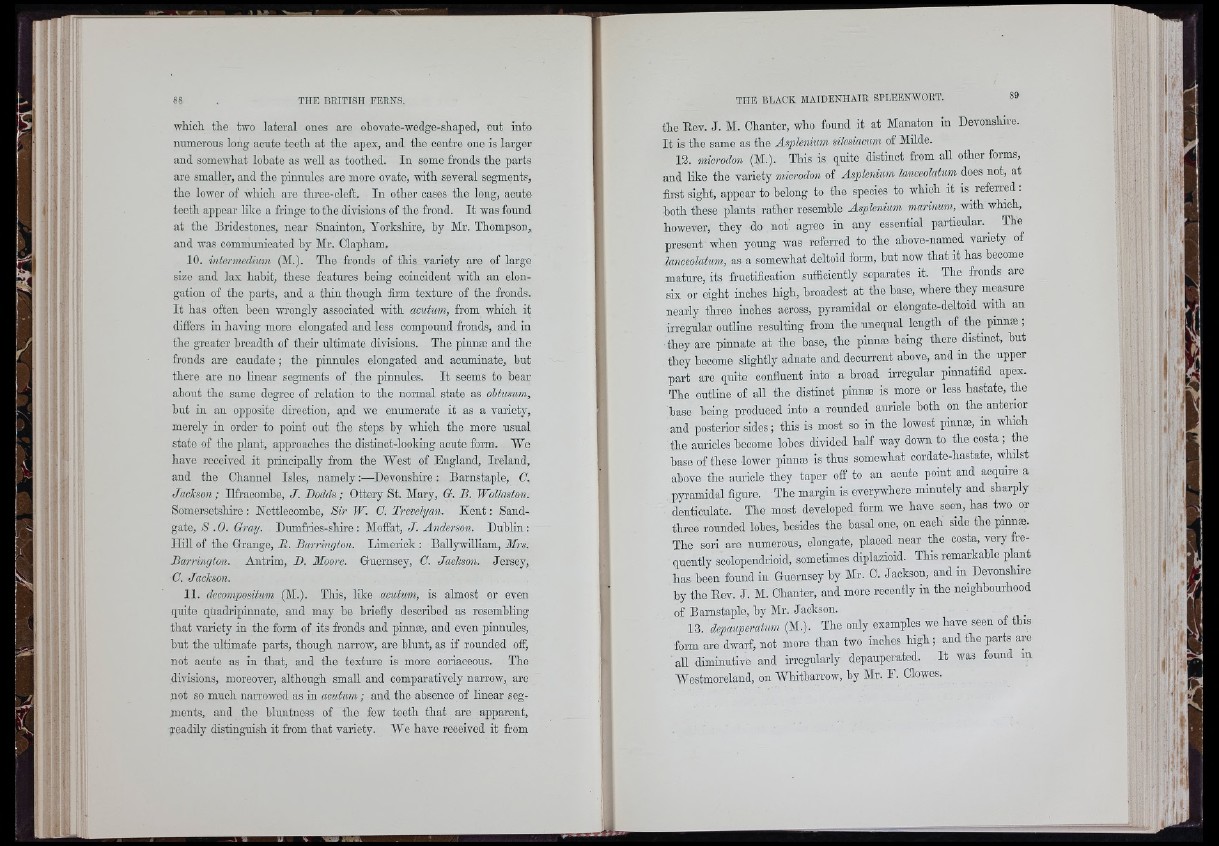
' J
which tho two lateral ones aro obovate-wodge-shapod, cut into
numerous long acuto teeth at tho apex, and the centre one is larger
aud somewhat lobate as well as toothed. In some fronds the parts
aro smaller, and tho pinnnles are more ovate, with several segments,
tho lower of which arc three-cloft. In other oases the long, acute
teeth appear like a fringe to the divisions of the frond. It was found
at tho Bridostoncs, near Snainton, Yorkshire, by Mr. Thompson,
and was communioated by Mr. Clapham.
10. intermedium (M.). The fronds of this variety are of large
size and lax habit, those features being coincident with an elongation
of tho parts, and a thin though firm texture of the fronds.
It has often boon wrongly associated with acutum, from which it
differs in having more elongated and loss compound fronds, and in
the greater breadth of their ultimate divisions. The pinnæ and the
fronds are caudate ; the pinnules elongated and acuminate, but
there aro no linear segments of the pinnules. It seems to boar
about the same degree of relation to the normal state as obtusum,
but in an opposite direction, and -wo enumerate it as a variety,
merely in order to point out the steps by ’which tho more usual
state of the plant, approaches the distinot-looldng acute form. We
have received it principally from the IVest of England, Ireland,
and the Channel Isles, namely :—Devonshire : Barnstaple, C.
Jackson ; Ilfracombe, J. Dodds ; Ottery St. Mary, G. B. Wollaston.
Somersetshire ; Nettlooombe, Sir W. 0. Trevelyan. Kent : Sand-
gato, S .0. Gray. Dumfries-shirG: Moffat, J. Anderson. Dublin:
Hill of the Grange, B. Barrington. Limerick : BallywiUiam, Mrs.
Barrington. Antrim, D. Moore. Guernsey, G. Jackson. Jersey,
O. Jackson.
11. dccompositim (M.). This, like acutum, is almost or even
quite quadripinnate, and may be briefly described as resembling
tbat variety in the form of its fronds and pinnæ, and even pinnules,
hut the ultimate parts, though narrow, are blunt, as if rounded off,
not acute as in that, and the texture is more coriaceous. Tho
divisions, moreover, although small aud comparatively narrow, aro
not so much narrowed as in acutum ; and the absence of linear segments,
and the hluntnoss of tho few tooth that are apparent,
readily distinguish it from that variety. "VYe have received it from
the Bov. J. M. Chanter, who found it at Manaton in Devonshire.
It is the same as the Asplenium silesiacum of Milde.
12. microdon (M.). This is quite distinct from all other forms,
and like the variety microdon of Asplenium lanceolatum does not, at
first sight, appear to belong to tho species to which it is referred:
both these plants rather resemble Asplenium marinum, with which,
however, they do not' agree in any essential particular.^ The
present when young was referred to the above-named variety of
lanceolatum, as a somewhat deltoid form, but now that it has become
mature, its fructification sufiioiently separates it. The fronds are
six or eight inches high, broadest at the base, where they measure
nearly three inches across, pyramidal or elongate-deltoid with an
irregular outline resulting from the unequal length of the^ pinnæ ;
they aro pinnate at the base, the pinnæ being there distinct, but
they become slightly adnate and decurrent above, and in the upper
part aro quite confluent into a broad irregular pinnatifid apex.
The outline of all the distinct pinnæ is more or less hastate, tho
base being produced into a rounded auricle both on the anterior
and posterior sides ; this is most so in the lowest pinnæ, in which
the auricles become lobes divided half way down to the costa ; tee
base of these lower pinnæ is tens somewhat cordate-hastate, whilst
above tee auricle they taper off to an acute point and acquire a
pyramidal figure. The margin is everywhere minutely and sharply
dontioiilate. The most developed form we have seen, has two or
three rounded lobes, besides the basal one, on each side the pinnæ.
The sori are numerous, elongate, placed near tee costa, very frequently
scolopendrioid, sometimes diplazioid. This remarkable pknt
has been found in Guernsey by Mr. C. Jackson, and in Devonshire
by the Eev. J. M. Chanter, and more recently in tee neighbourhood
of Barnstaple, by Mr. Jackson.
13. depauperatum (M.). The only examples we have seen of this
form are dwarf, not more than two inches high; and the parts aro
all diminutive and irregularly depauperated. It was found in
■Westmoreland, on Wliitbarrow, by Mr. F. Clowos.